

Soil Quality: A Concept, Definition, and Framework for Evaluation (A Guest Editorial. Managing Soil Health: Concepts and Practices. Introduction Healthy soil is the foundation for profitable, productive, and environmentally sound agricultural systems.
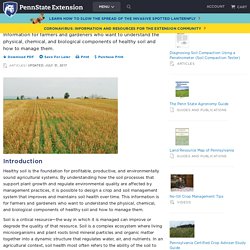
By understanding how the soil processes that support plant growth and regulate environmental quality are affected by management practices, it is possible to design a crop and soil management system that improves and maintains soil health over time. This information is for farmers and gardeners who want to understand the physical, chemical, and biological components of healthy soil and how to manage them.
Soil is a critical resource—the way in which it is managed can improve or degrade the quality of that resource. Soil is a complex ecosystem where living microorganisms and plant roots bind mineral particles and organic matter together into a dynamic structure that regulates water, air, and nutrients. How to Fill a Raised Garden Bed: Build the Perfect Organic Soil ~ Homestead and Chill. First things first, let’s set the record straight: “Dirt” is not soil!

Soil is rich, full of nutrients, and is biologically active! In contrast, dirt is usually devoid of all these things. Bioturbation - an overview. Bioturbation, the mixing of sediment, and bioirrigation, the pumping of solutes by animal activities, both exert major controls on redox conditions and biogeochemical processes within sediments.
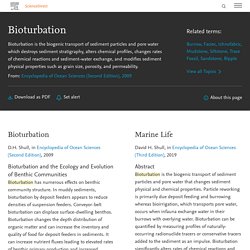
They also affect sediment stability and erosion, which will be covered more fully in Section 7.03.5. A wide variety of invasive species, including polychaetes, bivalves, and crustaceans, are bioturbators that affect invaded ecosystems. Invaders may increase or reduce rates of bioturbation relative to native faunal activities. Enhanced bioturbation has been reported in the Baltic Sea following invasion of the polychaete Marenzellaria, which burrows more deeply than the native Nereis diversicolor (Olenin and Leppäkoski, 1999).
Effects of Vermicompost in Potting Soils and Extract Foliar Spray. National Good Agricultural Practices Program. Soil Amendments Decision Tree (Full Portfolio) Components A soil amendment refers to any material added to the soil to improve its physical or chemical properties.
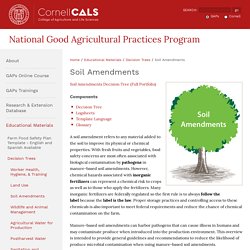
With fresh fruits and vegetables, food safety concerns are most often associated with biological contamination by pathogens in manure-based soil amendments. Center for a Livable FutureCenter for a Livable Future. This post is the second in a series—Connecting Agriculture Policy to Your Health—by CLF-Lerner Fellow Lacey Gaechter.
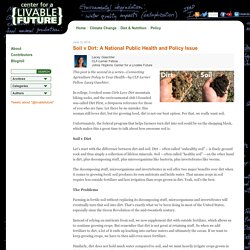
In college, I rocked some Girls Love Dirt mountain biking socks, and the environmental club I founded was called Dirt First, a Simpsons reference for those of you who are fans. Let there be no mistake: this woman still loves dirt, but for growing food, dirt is not our best option. For that, we really want soil. Certification. The Different Factors That Impact Soil Fertility - Better Meets Reality. Knowing the factors that impact soil fertility can help maintain and improve agricultural production, or figure out why a certain soil isn’t yielding much.
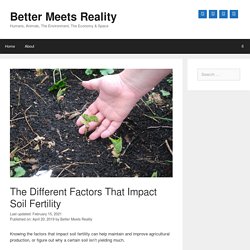
In this short guide, we outline the different factors that impact soil fertility. Summary Of Factors That Can Impact Soil Fertility. 2008 Soil Quality Assessment: UofNebraska 13pp. UMass Center for Agriculture, Food and the Environment. Quick Link:Greenhouse Media; Saturated Media Extract Submittal Form to be completed and sent with soil sample to the UMass Extension Soil and Plant Nutrient Testing Laboratory.
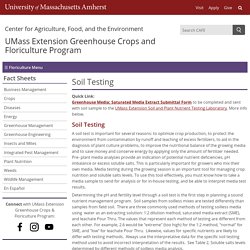
More info below. Soil Testing A soil test is important for several reasons: to optimize crop production, to protect the environment from contamination by runoff and leaching of excess fertilizers, to aid in the diagnosis of plant culture problems, to improve the nutritional balance of the growing media and to save money and conserve energy by applying only the amount of fertilizer needed. Does my compost have a high humic content? Compost contains humus, but there is no standard set for how much (the %).

We believe most mature composts have around 10% (+/- 5%) humus. If you compared this to a commercial 'humic fertiliser' derived from ligninite, this would have >65% humic content. The exact amount of humus is likely to vary with each batch of compost. Allophane - an overview. 1.1.3.2 Allophane and Imogolite Allophane may be defined as ‘…a group of clay-size minerals with short-range order which contain silica, alumina, and water in chemical combination’ (Parfitt, 1990).
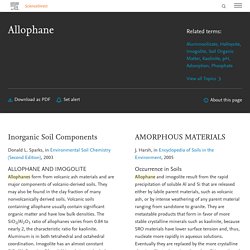
Allophane, either by itself or frequently together with imogolite, occurs in the clay fraction of many soils, especially those that derive from volcanic ash and weathered pumice. Not all allophanes, however, are associated with soil environments. A prime example is the type that occurs as a deposit on a stream bed near Silica Springs, New Zealand. Because of their variable composition, allophane, like illite, should be regarded more as a series of minerals than as a mineral species.
Allophane: Mineral information, data and localities. Hausmann, J.F.L. and Stromeyer, F. (1816) Über Silberkupferglanz und Allophan.

Göttingische Gelehrte Anzeigen: 2: 1251-1253. Dana, E.S. (1892) Dana's system of mineralogy (6th edition), 693-694. Ross, C., Kerr, P. (1934) Halloysite and allophane. U.S. Geological Survey Professional Paper, 185G, 135. Soil Food Web. By Elaine R. Ingham An incredible diversity of organisms make up the soil food web. They range in size from the tiniest one-celled bacteria, algae, fungi, and protozoa, to the more complex nematodes and micro-arthropods, to the visible earthworms, insects, small vertebrates, and plants. As these organisms eat, grow, and move through the soil, they make it possible to have clean water, clean air, healthy plants, and moderated water flow. Soil quality concept tool for promoting sustainability considerations. 3 Soil Amendments PSA GAP. Organic Fertilizer - What is it's real value? In my last post What is Organic Fertilizer I explained why the nutrients in organic fertilizer and synthetic fertilizer are the same.
Plants can’t tell the difference between the two because there is no difference. However, organic fertilizer is better for the garden. Soil health derives from strong interaction between the physical, chemical, and biological components of the soils. Geology, topography, climate, vegetation, human activity, time shape soil fertility, biodiversity, nutrient recycling, carbon sequestration. Soil texture by feel - Soil Doctor. Web Soil Survey. RE:View. Dirt! The Movie (FULL) PHC Film: Soil is a living organism. CDFA - OEFI - Healthy Soils Program. Pay Up. Symphony of the Soil. Humus Does not Exist - Says New Study - Garden Myths. As a gardener we all talk about humus.
Some of us even buy humus soil, and humic substances like humic acid and fulvic acid. We add compost to gardens to increase the humus level in our soils in the belief that humus is good for soil. The contentious nature of soil organic matter. 1Ciais, P. et al. in Climate Change 2013: The Physical Science Basis (eds Stocker, T. F. et al. ) 465–570 (Cambridge Univ. Press, 2013)2Lal, R. Soil carbon sequestration impacts on global climate change and food security. Agriculture. COMPOST. NATURE BEING. Nematode Health. Water. Soil.